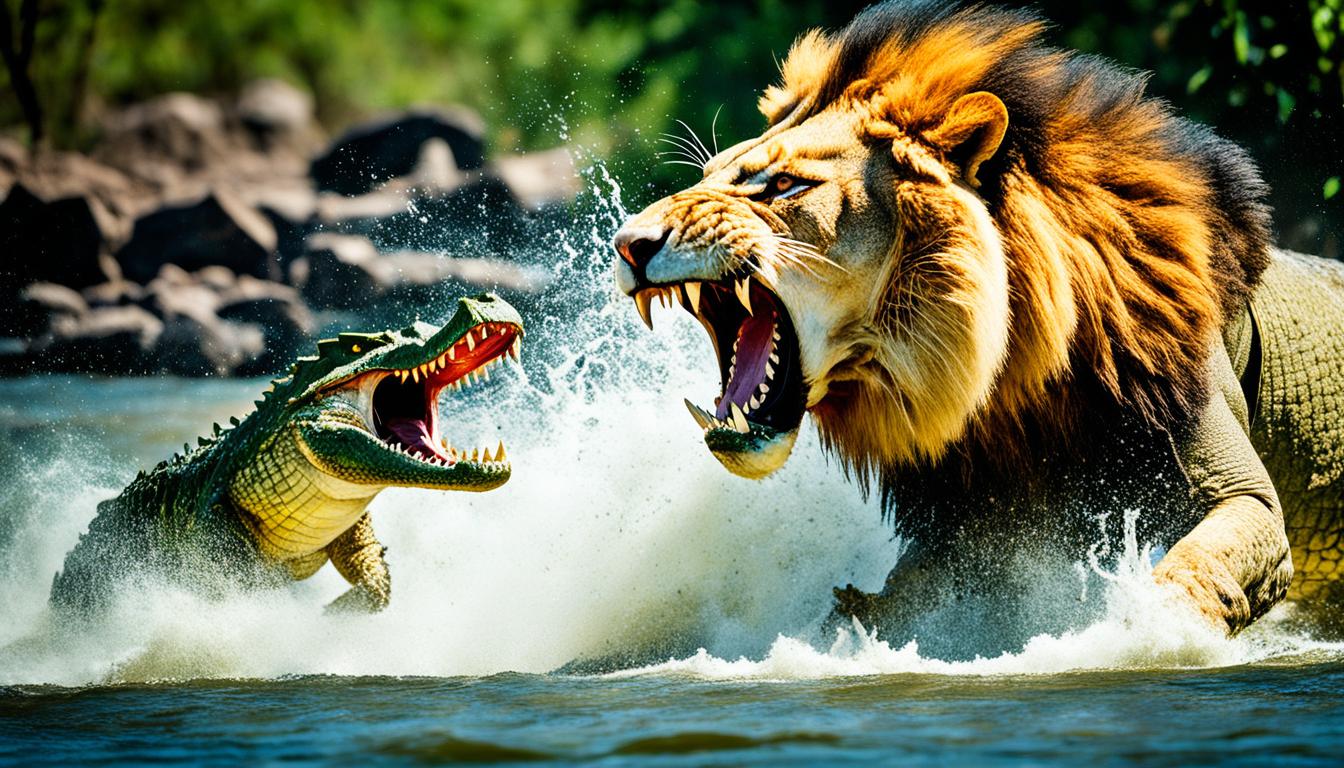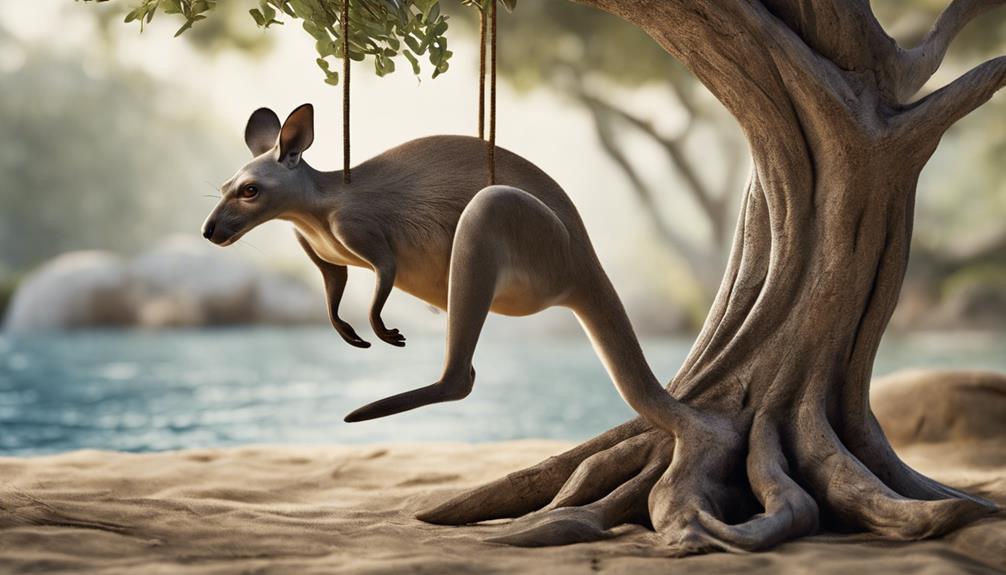Did you know that when lions and crocodiles face off, it’s a battle of epic proportions? These apex predators, with their immense strength and ferocity, engage in intense clashes that captivate wildlife enthusiasts worldwide. Get ready to explore the thrilling world of lion vs crocodile encounters and witness the raw power of these majestic beasts.
Key Takeaways:
- Lion vs crocodile encounters showcase the natural rivalry and intensity between these two powerful predators.
- Crocodiles’ immense size and armored hide give them a distinct advantage in battles.
- Territorial dynamics and waterways play a significant role in lion-crocodile interactions.
- Real-life battles and wildlife encounters offer a glimpse into the fierce competition and survival instincts of both species.
- Studying lion vs crocodile encounters provides valuable insights into wildlife behavior and predator-prey relationships.
Lion vs Crocodile Encounter in Zambia
A field guide in South Luangwa, Zambia captured incredible aerial footage of a lioness and a crocodile fighting over a zebra carcass. This encounter, featured on popular Instagram page Lion Sightings, showcases the intense battle between these two animals as they both fought for control over the zebra kill. The footage has been described as truly epic and highlights the natural rivalry between lions and crocodiles.
To witness such a remarkable confrontation between apex predators is a rare and extraordinary event. The footage provides a unique glimpse into the fierce competition and survival instincts of these magnificent creatures. It serves as a powerful reminder of the untamed wilderness and the struggles that unfold within it.
As the lioness and crocodile clash over the zebra carcass, their primal instincts take over, creating a thrilling spectacle that captivates viewers. Their sheer strength, agility, and determination are on full display, as they engage in a battle for dominance and sustenance.
The encounter between the lioness and crocodile in Zambia perfectly encapsulates the raw power and natural rivalry between these apex predators. It’s a true testament to the fierce competition that exists within the animal kingdom.
Zambia’s diverse wildlife and vast landscapes provide the ideal setting for such dramatic interactions. The country’s abundant waterways and rich ecosystems attract a wide variety of animal species, making it a prime location for witnessing unique wildlife encounters.
The lion vs crocodile footage serves as a reminder of the fragility and complexity of nature. The delicate balance between predation and survival, where every meal could mean life or death, is exemplified in this epic battle. It provides a glimpse into the harsh realities of the natural world, where every animal must fight for its place in the food chain.
Size and Strength Comparison
In the battle between lions and crocodiles, size and strength play a crucial role in determining the outcome. While lions are undoubtedly large and powerful predators, crocodiles surpass them in both size and bulk. Let’s take a closer look at the incredible physical attributes of these formidable beasts.
Lions: Mighty Predators
Lions are known for their majestic presence and commanding presence in the savannah. Male lions, or lions, typically weigh between 330 and 500 pounds, with some exceptional individuals exceeding the 550-pound mark. Lionesses, on the other hand, are slightly smaller and average around 250-350 pounds.
Lions are renowned for their muscular build, a product of their daily hunts and territorial battles. Their endurance enables them to pursue agile prey like wildebeests and zebras, relying on their strength and teamwork to overpower them. With their sharp claws and powerful jaws, lions possess the necessary tools to bring down large herbivores and maintain their position as apex predators in their domain.
Crocodiles: Size Matters
In comparison to lions, crocodiles take size to a whole new level. The Nile crocodile, one of the largest crocodile species, can reach lengths of up to 20 feet and weigh over 1,200 pounds. These enormous reptiles tower over the average lion, dwarfing them in sheer size.
It’s not just their length and weight that put crocodiles at an advantage—they are equipped with a formidable armored hide as well. Their scaly skin, composed of thick osteoderms, acts as a protective shield, making it challenging for predators like lions to penetrate and inflict significant damage. This natural armor makes them an exceptionally tough opponent in any battle they encounter.
A Visual Comparison
| Lion | Crocodile | |
|---|---|---|
| Weight: | 1,200+ pounds | |
| (Nile crocodile) | ||
| Length: | Up to 20 feet | |
| (Nile crocodile) | ||
| Physical Attributes: | Powerful muscles, sharp claws, strong jaws | |
| Armored hide, thick osteoderms |
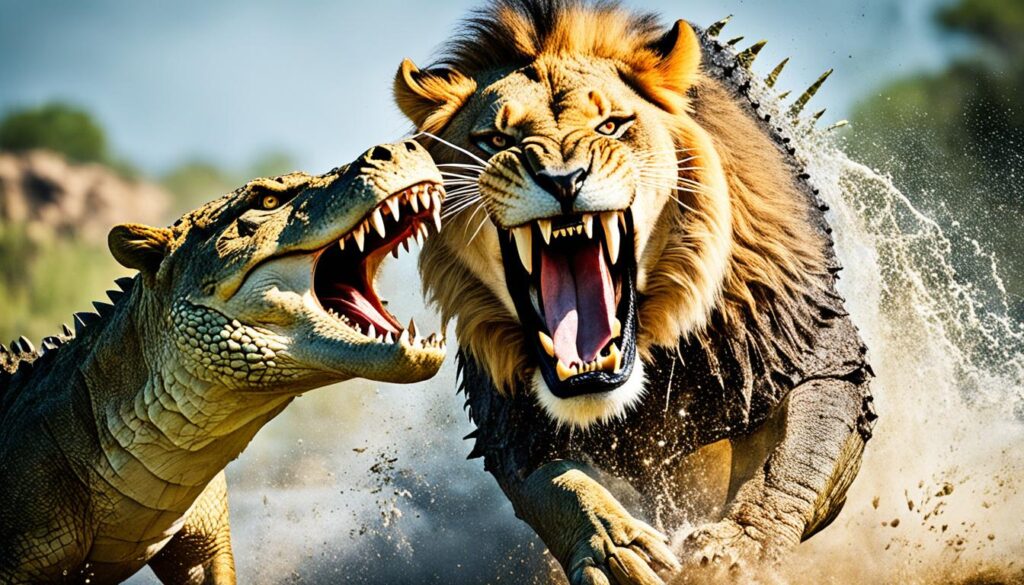
Note: The image above illustrates the size difference between a lion and a crocodile.
As the table above and the image demonstrate, crocodiles possess significant advantages over lions in terms of size and physical attributes. However, it’s important to remember that battles between these beasts are rare, and the outcome is influenced by various factors such as location, individual characteristics, and the element of surprise.
Territories and Waterways
Lions and crocodiles both inhabit the diverse landscapes of Africa, where their territories often intersect. While they may share certain areas, each species has distinct domains and behaviors that shape their interactions.
When it comes to waterways, lions are acutely aware that these are the territory of the crocodile. Lions exercise caution when approaching these areas, well aware of the formidable predators lurking beneath the surface. The adaptive nature of these majestic felines makes them cautious and strategic, avoiding unnecessary confrontations in crocodile-dominated waters.
**”Waterways are the territory of the crocodile.**”
Larger crocodiles pose an even greater threat to lions due to their immense size and weight. While lions possess incredible strength and hunting skills, they can be outmatched by a massive crocodile in close proximity. This understanding of the natural hierarchy reinforces the importance of respecting each other’s territories to minimize conflicts and ensure survival.
**”Lions exercise caution when approaching waterways and recognize larger crocodiles as more formidable opponents.”**
The intertwining of territories and waterways in the African wilderness creates a delicate balance between these two apex predators. Lions and crocodiles have adapted to coexist, each respecting the other’s domain while engaging in a constant battle for resources and survival.

Real-Life Battles – Lions and Crocodiles in Action
In the untamed wilderness, thrilling showdowns between lions and crocodiles unfold, showcasing the sheer power and survival instincts of these formidable predators. Real-life wildlife encounters have captured these battles, providing a glimpse into the fierce competition that reigns in the wild.
In the Great Migration, crocodiles lie in wait in the treacherous Mara River, ready to ambush unsuspecting wildebeests as they brave the treacherous waters. With lightning-fast movements, these stealthy reptiles clamp down on their prey, displaying their deadly hunting prowess.
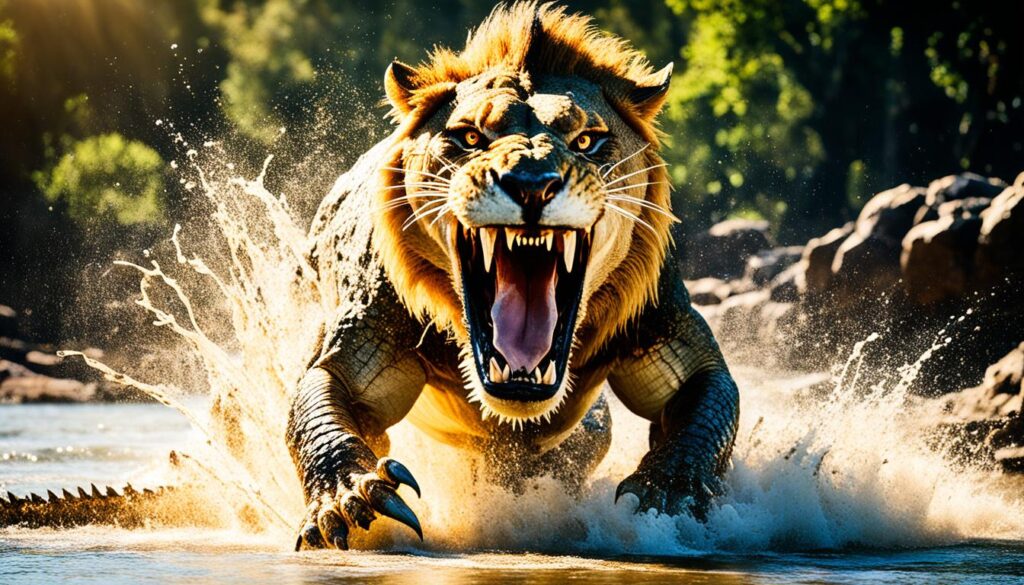
Lionesses, known for their hunting prowess, fiercely guard their kills from opportunistic crocodiles. These fierce battles can unfold at the water’s edge as the lioness valiantly defends her hard-earned meal from the chilling jaws of the crocodile, showcasing the raw determination and protective instincts of these brave big cats.
“Witnessing a lioness, teeth bared and claws unsheathed, facing off against a crocodile is a truly exhilarating experience,” shared Mufasa Safaris guide, David Ndlovu. “The intensity of these real-life battles is a testament to the relentless pursuit of survival in the wild.”
These incredible encounters, often captured by safari guides and wildlife enthusiasts, offer a glimpse into the captivating world of wildlife’s battles for survival. Such confrontations between lions and crocodiles underscore the dynamic and diverse nature of the animal kingdom, leaving viewers in awe of nature’s extraordinary spectacle.
Lion vs Crocodile – A Comparison of Real-Life Battles
| Battle | Lion | Crocodile |
|---|---|---|
| The Great Migration | Lionesses protecting their kills from crocodiles at the river’s edge. | Crocodiles ambushing wildebeests as they cross dangerous rivers. |
| In the Water | Lions cautiously approaching waterways, aware of the crocodile’s territory. | Crocodiles patiently waiting for the perfect moment to strike. |
| Mealtime Showdown | Lionesses fiercely defending their hard-earned kill from crocodile attacks. | Crocodiles attempting to steal a lion’s meal, testing their bravery. |
These real-life battles between lions and crocodiles serve as a reminder of the raw power and indomitable spirit found in nature. Each encounter provides valuable insights into the intricate dynamics of the animal kingdom, leaving us in awe of the remarkable tales of survival.
Lion vs Crocodile Documentary – Epic Showdown
The concept of a lion vs crocodile battle has also been explored in media and entertainment. Shows like the “Epic Animal Matchups” series present hypothetical battles between various animals, including lions and crocodiles. While these matchups are not real, they provide an opportunity to imagine the outcomes of such encounters and the different strategies each animal might employ.

In these fascinating documentaries, experts simulate the epic showdown between a lion and a crocodile by analyzing their strengths, weaknesses, and natural behaviors. Through computer-generated imagery and expert analysis, viewers are transported into a virtual arena where these formidable adversaries clash.
“The lion, with its prowess in land-based hunting, relies on speed, strength, and a highly coordinated pack strategy. In contrast, the crocodile is the undisputed king of the water, armed with powerful jaws, exceptional camouflage, and an impressive ability to remain submerged for extended periods.”
Using scientific research, wildlife experts dissect the abilities and strategies of both the lion and the crocodile, shedding light on the different tactics each predator employs in their respective habitats. By examining these epic matchups in a controlled and simulated environment, audiences gain a deeper understanding of the dynamics between these fierce rivals.
The Key Takeaways from the Lion vs Crocodile Documentary
- The battlefield: Lions dominate the savannah, while crocodiles reign in the waterways.
- The weaponry: Lions possess sharp claws, powerful jaws, and agility, while crocodiles boast immensely strong jaws and a thick, impenetrable hide.
- The tactics: Lions utilize pack hunting and communication skills, while crocodiles employ stealth and ambush techniques to catch their prey.
- Strongholds: Lions maintain control over vast territories, while crocodiles claim their dominion over selected water bodies.
- Surprises: Both lion and crocodile possess incredible strength and adaptability, making the outcome of their encounters unpredictable.
| Aspect | Lion | Crocodile |
|---|---|---|
| Size | Lions are large predators, with males weighing up to 400 pounds. | Crocodiles can grow much larger, with the Nile crocodile reaching lengths of up to 20 feet and weighing over 1,200 pounds. |
| Strength | Lions possess immense strength and can bring down large prey. | Crocodiles are incredibly powerful, capable of overpowering animals many times their size. |
| Environment | Lions thrive on land in savannahs, where their speed and agility give them an advantage. | Crocodiles reign in the water, using their aquatic prowess to silently stalk and capture prey. |
Lion vs Crocodile in Popular Culture
The epic battle between lions and crocodiles has left an indelible mark on popular culture, permeating various forms of entertainment. From the big screen to video games, these fierce clashes have become a recurring theme that captivates audiences of all ages.
Cartoons and animated movies have brought the lion vs crocodile battles to life, depicting thrilling encounters that ignite the imagination. Characters like Simba from “The Lion King” and Tick-Tock the Crocodile from “Peter Pan” have become iconic representations of this age-old rivalry.
“In every culture and in every part of the world, battles between predators have always fascinated people. The lion vs crocodile showdown taps into our primal instincts and triggers a sense of wonder and excitement.” – Dr. Jane Miller, Cultural Anthropologist
The clash between lions and crocodiles has also made its way into the world of video games, allowing players to partake in virtual battles between these formidable creatures. Games like “Monster Hunter” and “Zoo Tycoon” feature scenarios where players must strategize and navigate the intense encounters between lions and crocodiles.
Books and literature have not been spared from the allure of this rivalry. Authors have crafted gripping tales that highlight the power dynamics and primal instincts of lions and crocodiles. These narratives transport readers into vivid worlds where these legendary battles unfold.
In Popular Culture: Lion vs Crocodile
- “The Lion vs The Croc: Kings of the Wild” – a comic book series that explores the epic battles between lions and crocodiles in the heart of the African savannah.
- “Jungle Fury” – an action-packed novel that follows a courageous lion as he confronts a cunning crocodile in a brutal battle for dominance.
While these portrayals may not accurately reflect the reality of lion vs crocodile battles in the wild, they serve as a source of entertainment and fascination for individuals worldwide. These imaginative creations allow us to explore the depths of these predators’ abilities and marvel at the sheer force they possess.
In the Battle: Lion vs Crocodile
| Lion | Crocodile |
|---|---|
| Symbol of courage, strength, and pride | Revered as a symbol of power and ancient wisdom |
| Characterized by agility and ferocity | Known for their stealth and deadly ambushes |
| Pop culture icons: Simba from “The Lion King”, Aslan from “The Chronicles of Narnia” | Pop culture icons: Tick-Tock the Crocodile from “Peter Pan”, Leatherhead from “Teenage Mutant Ninja Turtles” |
Through popular culture, the lion vs crocodile battles continue to capture our imaginations and fuel our curiosity about these fierce encounters. While they may be fictionalized for the purposes of entertainment, they remind us of the awe-inspiring nature of the animal kingdom and our fascination with the untamed world.
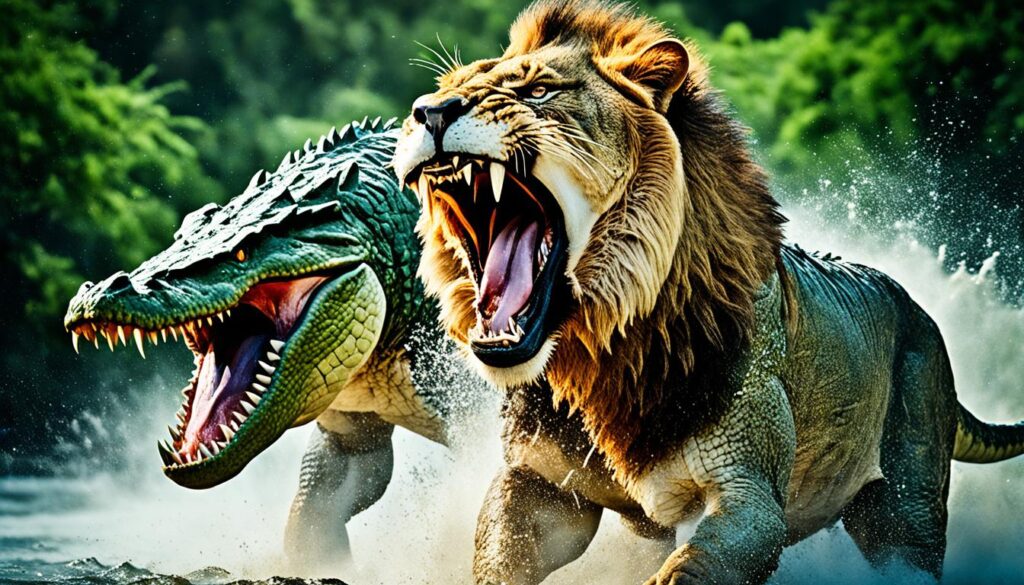
The Significance of Lion vs Crocodile Encounters
Lion vs crocodile encounters provide valuable insights into wildlife behavior and the dynamics of predator-prey relationships. These interactions highlight the adaptability and intelligence of both species, as well as their ability to compete for resources in their shared habitat.
When lions and crocodiles come face to face, it reveals a fascinating glimpse into the survival strategies employed by these awe-inspiring creatures. Through careful observation and analysis of these encounters, scientists and researchers gain a deeper understanding of the intricacies of the natural world.
Studying lion and crocodile behavior during these encounters helps uncover their instincts, hunting techniques, and defensive maneuvers. By examining how these animals adapt to their environments and interact with one another, valuable information is gathered that contributes to our overall understanding of wildlife behavior.
Furthermore, these encounters serve as a window into the complexity and fragility of predator-prey relationships. Lions, as formidable hunters, face a unique challenge in dealing with crocodiles, which possess their own set of advantages. This interplay between predator and prey provides valuable insights into the balance of power in ecosystems and the ways in which different species coexist.
| Lion vs Crocodile Encounters | Insights |
|---|---|
| Adaptability and Intelligence | Lions and crocodiles showcase their ability to adapt to changing circumstances and display intelligence in their strategies. |
| Competition for Resources | These encounters highlight the fierce competition between lions and crocodiles for food and territory. |
| Predator-Prey Dynamics | Studying these interactions provides a deeper understanding of the delicate balance between predators and their prey. |
By studying lion vs crocodile encounters, we gain valuable knowledge that can be applied to conservation efforts and the preservation of wildlife habitats. This research helps shape strategies aimed at maintaining healthy ecosystems and ensuring the long-term survival of these magnificent animals.
Lion vs Crocodile – A Battle of Instincts
The battle between a lion and a crocodile represents a clash of instincts. Lions rely on their strength, agility, and pack behavior to hunt and defend their territory, while crocodiles utilize their powerful jaws, stealth, and aquatic advantages to secure their prey and protect their domain. Understanding these instincts and the strategies animals employ in their natural habitat enhances our appreciation for the complexities of the animal kingdom.
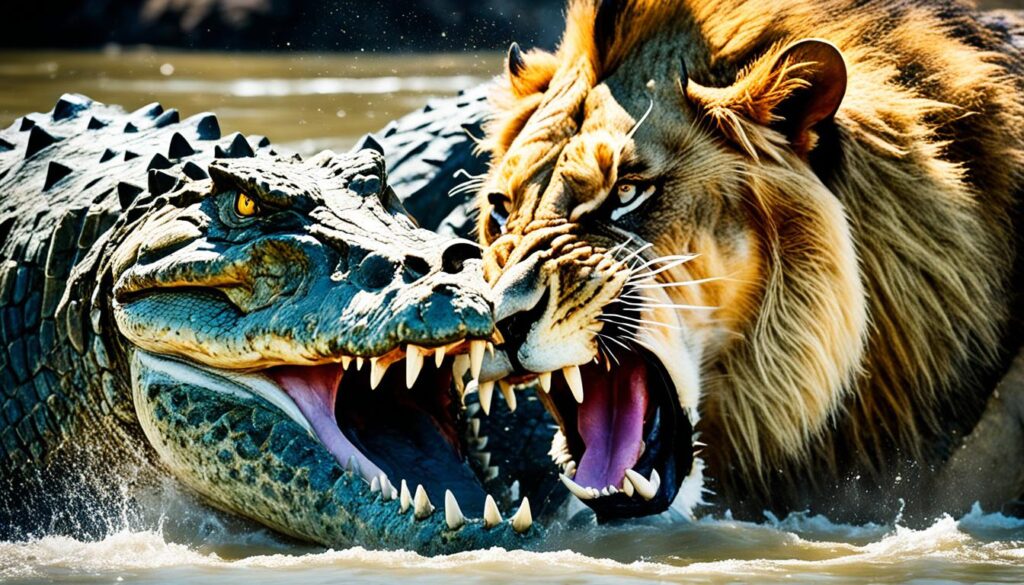
The Unpredictable Outcome – Who Would Win?
Despite speculation and hypothetical matchups, the outcome of a lion vs crocodile battle remains unpredictable. Various factors such as size, location, and individual characteristics of each animal can significantly impact the outcome. While lions possess incredible strength and hunting skills, crocodiles’ armored hide and water-dwelling abilities give them a formidable advantage. Ultimately, the result of such a battle will depend on the unique circumstances and dynamics of the encounter.
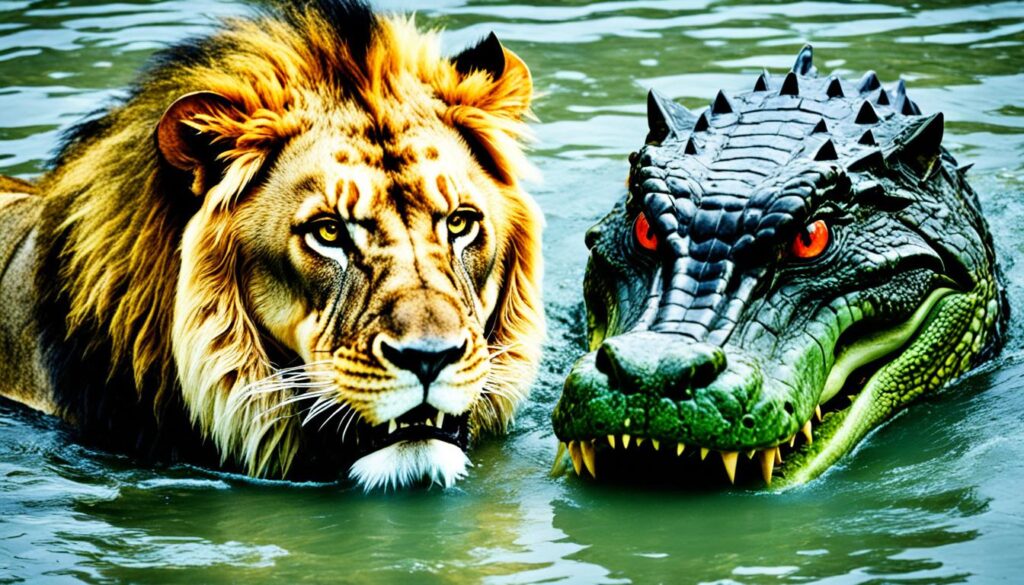
When considering a clash between a lion and a crocodile, it’s hard to determine a clear winner. Both predators are highly skilled in their respective domains and possess unique adaptations that contribute to their hunting success. Lions, known for their powerful physique and cooperative hunting strategies, are apex hunters on land. On the other hand, crocodiles, with their massive size and well-armored bodies, are unrivaled masters of water. This stark contrast in strengths and habitats creates an intriguing battle scenario with an uncertain outcome.
Lions are known for their exceptional strength and agility. These social felines work together in coordinated hunting efforts, utilizing their speed, sharp claws, and strong jaws to bring down large prey. Their famous roars and majestic manes symbolize their dominance on the African savannah. However, when it comes to confronting a crocodile, their prowess on land might not be enough to ensure victory.
Crocodiles, on the other hand, are perfectly adapted to thrive in aquatic environments. With their armored scales, formidable jaws, and muscular bodies, they are perfectly designed killing machines. Their ambush hunting style and ability to submerge underwater make them lethal predators near water sources such as rivers and lakes. In a face-off against a lion, a crocodile’s size, strength, and aquatic supremacy could tip the scales in their favor.
The unpredictable outcome of a lion vs crocodile battle serves as a testament to the diversity and complexity of the natural world. Factors such as size, location, and individual skills play crucial roles in determining the victor. Each encounter is a unique blend of instinct, strategy, and adaptability, making it impossible to predict a definitive winner. The battle between a lion and a crocodile remains an enigma, leaving us in awe of nature’s unpredictable wonders.
Conclusion
The battle between a lion and a crocodile is a captivating display of the raw power and instinctual nature of these majestic beasts. Whether witnessed in real life or explored through various media and entertainment platforms, this clash between two formidable predators never fails to intrigue and fascinate people around the world. The epic showdown between a lion and a crocodile reaffirms their status as top contenders in the animal kingdom, each equipped with unique strengths and strategies.
While the outcome of such battles may be uncertain, the sheer force and tenacity displayed by lions and crocodiles are a testament to their dominance in their respective habitats. Lions, with their impressive agility and pack hunting capabilities, showcase the true power of teamwork and coordination in securing their prey and defending their territory. On the other hand, crocodiles, with their massive size, armored hide, and stealthy ambushing techniques, exhibit the unparalleled strength and survival skills required to thrive in aquatic environments.
The battle of the beasts, lion versus crocodile, serves as a reminder of the complexities and wonders of nature. The continuous study and observation of these encounters provide valuable insights into wildlife behavior and the intricate dynamics of predator-prey relationships. Whether scientists and researchers seek to unravel the mysteries of the animal kingdom or audiences simply yearn for an up-close and personal glimpse into the natural world, the lion versus crocodile battle never fails to deliver excitement and awe.
